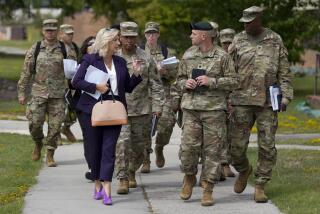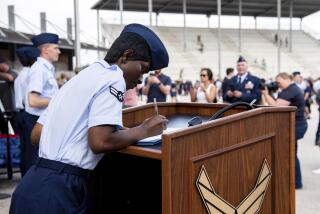Army’s New Message to Attract Recruits: Uncle ‘Sim’ Wants You
- Share via
America’s youth would rather play video games than do push-ups in the mud--a reality the Army wants to harness to its advantage.
Eager to prove it’s not your grandfather’s military, the Army is developing video games to recruit and build awareness among Generation Y.
Today at the Electronic Entertainment Expo in Los Angeles, the Army will unveil two games designed to appeal to a media-saturated, tech-bombarded generation. One is a sanitized version of “Unreal Tournament,” a classic first-person shooting game known for its graphic, nonstop killing. The other is a take on “The Sims,” a popular game that mimics life itself.
But instead of dismembering mutants or pursuing romance, players can work on their organizational skills, free hostages and rise to the rank of first sergeant. The games are part of the Army of One marketing campaign, which stresses professionalism and the importance of the individual, themes marketers say resonate with youths.
Though the military has long used realistic video games as training tools, this is the first time the Army has relied on games to reach out to the public. The intent of the free games--which will be distributed starting in July at recruiting stations and on the Army Web site--is to sell the soldiering life.
Although interest in military careers rose after the Sept. 11 terrorist attacks, enlistments have changed little in recent years. And it’s getting tougher to attract and retain soldiers, in part because there are fewer veterans to regale potential recruits with tales of their military exploits.
“The goal was to give them a synthetic experience of being in the Army in game form,” said Michael Zyda, director of the Naval Postgraduate School’s Modeling, Virtual Environments and Simulation Institute in Monterey, which developed both games.
“When I registered for the draft during the Vietnam War, I asked veterans of the Korean War what it was like,” he said. “They were easy to find. Today, the Army is much smaller. There aren’t as many people around today to answer that question.”
The game project started two years ago, when the economy was bursting at the seams and dot-coms beckoned young people with the promise of riches and freewheeling offices in which they could skateboard. The Army spent $5 million to develop video games to show Army life. Like unscripted TV shows, the games show mostly action, leaving out the boring parts.
“Soldiers,” for example, takes gamers from basic training to career development. Spit-shining shoes and peeling potatoes are not among the list of activities. Players going through sniper training in the more action-oriented “Operations” game don’t have to camp out for hours waiting for terrorists to show up.
The games depict an Army that is precise, organized and technically advanced. Tactical missions and advanced weaponry are the focus of the game’s missions, not violence.
In a survey this year by Northwestern University of 1,000 college students, the No. 1 concern about joining the military was danger, said Charles Moskos, professor of sociology at Northwestern and an expert on public attitudes toward the military.
“It’s something recruiters just don’t talk about,” Moskos said. “But being in the Army is as dangerous as being a taxicab driver, which is considered to be one of the most hazardous occupations.”
Because of such concerns, the armed forces have a difficult time replenishing their ranks. The military spends twice as much recruiting each soldier today--about $10,000--as it did 10 years ago.
Although the Army met its recruitment targets in three of the last five years--about 80,000 a year--those goals are far lower than in the past, Moskos said.
Given the current global climate, America is “likely going to need more people in the armed forces in the coming years,” he said. “That’s when the recruitment shortfalls will come.”
Although store shelves are bulging with video games that have military themes, some of which are so realistic they are used by the military to train soldiers, commercial games such as “Halo” lack the realism of being in the Army, Zyda said.
Technical realism, in fact, is one of the biggest selling points of the two new games.
To make “Operations,” developers rode tanks and Blackhawk helicopters, parachuted from airplanes and shot rifles and machine guns. They brought in soldiers from the Army’s Special Forces to critique scenes and levels. They scanned images of 12 weapons and programmed their recoils, accuracies and bullet speeds into the game. For “Soldiers,” developers videotaped real soldiers and drill sergeants.
Will that be good enough?
“It can’t hurt,” Moskos said. “But a video game isn’t going to be as good as real personal contact.”
Or like doing push-ups in the mud.
More E3 coverage is at www.latimes.com/e3.






